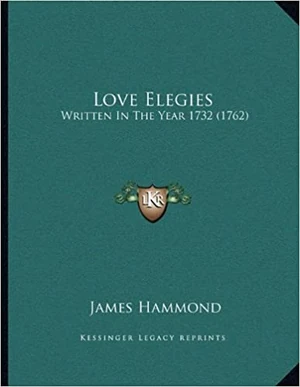
James Hammond (1710-1742), Love Elegies: Written in the year 1732 (1762). Kessinger, 2010. Courtesy Amazon.com.
James Hammond (22 May 1710 - 7 June 1742) was an English poet and British politician.
Life[]
Hammond was the 2nd son of Anthony Hammond (1668-1738) of Somersham Place, Huntingdonshire, who married at Tunbridge, 14 Aug. 1694, Jane, the only daughter of Sir Walter Clarges. His mother was famous for her wit; his father, both a wit and a keen politician, was a reckless spendthrift, though from an extract from his commonplace-book (Rawlinson MSS. Bodl. Libr. A. 245, printed in Notes and Queries) it seems that he had sufficient forethought to obtain for his son James a commission as ensign in March 1713, when the child was only 3 years old.[1]
Hammond was educated at Westminster School; at about the age of 18 he was, by means of Noel Broxholme, M.D. (who afterwards married Hammond's sister), introduced to Lord Chesterfield, and soon became a member of the clique, comprising Cobham, Lyttelton, and Pitt, which gathered round Frederick, prince of Wales. In 1733 his relative, Nicholas Hammond, left him the sum of £400 a year, and he became attached to the prince's court as an equerry.[1]
His tastes varied. Sometimes he would plunge deeply into the pleasures of social life — in December 1736 Lyttelton calls him "the joy and dread of Bath" — at others he withdrew into the country to bury himself among books.[1]
Through the prince's influence, as Duke of Cornwall, Hammond was elected to Parliament on 13 May 1741 as member for Truro. Horace Walpole records that "he was a man of moderate parts, attempted to speak in the House of Commons and did not succeed," but it should be borne in mind that the prince's friends and Sir Robert Walpole's adherents were bitter enemies.[1]
A popular tradition is that Hammond fell in love with Catherine (commonly called Kitty) Dashwood, the toast of the Oxfordshire Jacobites, and the intimate friend of Lady Bute, who was afterwards bedchamber woman to Queen Charlotte, and that she at first accepted, then rejected, his suit for prudential reasons. He, so the story adds, died of love; she survived until 1779. Walpole asserts that the lady, though much in love with Hammond, broke off all connection with him on "finding that he did not mean marriage."[1] Beattie was informed on good authority that Hammond was not in love when he wrote his elegies (Dissertations, Moral and Critical, 1783, p. 554). He undoubtedly lived for ten years after he had composed the effusions in which he set out his passion.[2]
In 1740 Hammond wrote the prologue for Lillo's posthumous tragedy of Elmerick, which was acted at Drury Lane Theatre.[2]
Hammond fell into bad health, and died at Stowe in Buckinghamshire on 7 June 1742 while on a visit to Lord Cobham. By the will his body was to be buried where he died, but this injunction was disregarded.[1]
Writing[]
His volume of poems was entitled Love Elegies by Mr. H——nd. Written in the year 1732. With Preface by the E. of C——d., 1743, in which Chesterfield wrote that his friend "died in the beginning of a career which, if he had lived, I think he would have finished with reputation and distinction."[2]
The elegies were mostly inscribed to Neæra or to Delia, but one was in praise of George Grenville, and another was pointedly addressed to Miss Dashwood, and to this Lord Hervey wrote an answer, also printed in Dodsley's collection, iv. 73–8. Some additional poems by him and references to his compositions are in the ‘Gentleman's Magazine’ for 1779, 1781, 1786, and 1787.[2]
Hammond's elegies are avowedly imitations of Tibullus, and Johnson condemned them as having "neither passion, nature, nor manners," nothing "but frigid pedantry." These strictures produced a quarto pamphlet of Observations on Dr. Johnson's Life of Hammond, 1782, but time has given its verdict in favour of the critic.[2]
Recognition[]
Thomson's Winter includes a glowing apostrophe to Hammond.[2]
The elegies are included in Johnson's, Anderson's, and Chalmers's collections of English poets, and were often republished, e.g. by Thomas Park in 1805 and George Dyer in 1818.[2]
Publications[]
Poetry[]
- An Elegy to a Young Lady: In the manner of Ovid ... with an answer: by a lady (with Lady Mary Wortley Montagu). London: J. Roberts, 1733.
- Love Elegies: Written in the year 1732. London: G. Hawkins, 1742; Edinburgh: W. Ruddiman jun., 1759; 5th edition, London: G. Hawkins, 1762; Dublin: B. Smith, for James Potts, 1782; London: E. Hodson, for J. Deighton, 1791.
- Poetical Works. Edinburgh: Apollo Press, by the Martins, 1781.
- Poetical Works. Glasgow: Andrew Foulis, 1787.
- Poetical Works. Glasgow: R. Chapman, for Richard Scott, 1798.
Except where noted, bibliographical information courtesy WorldCat.[3]
See also[]
References[]
Courtney, William Prideaux (1890) "Hammond, James" in Stephen, Leslie; Lee, Sidney Dictionary of National Biography 24 London: Smith, Elder, pp. 246-247. Wikisource, Web, Jan. 16,2017.
Notes[]
External links[]
- Poems
- James Hammond at the Eighteenth Century Poetry Archive (4 poems)
- James Hammond at PoemHunter (16 poems)
- James Hammond at AllPoetry (16 poems)
- Books
- James Hammond at Amazon.com
- About
This article incorporates text from a publication now in the public domain, the Dictionary of National Biography (edited by Leslie Stephen). London: Smith, Elder, 1885-1900. Original article is at: Hammond, James
|